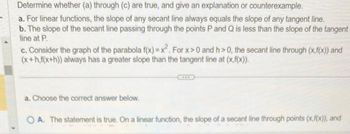Determine whether (a) through (c) are true, and give an explanation or counterexample. a. For linear functions, the slope of any secant line always equals the slope of any tangent line. b. The slope of the secant line passing through the points P and Q is less than the slope of the tangent line at P. c. Consider the graph of the parabola f(x)=x2². For x>0 and h>0, the secant line through (x.f(x)) and (x+h,f(x+h)) always has a greater slope than the tangent line at (x,f(x)). a. Choose the correct answer below. OA. The statement is true. On a linear function, the slope of a secant line through points (x, f(x)), and
Determine whether (a) through (c) are true, and give an explanation or counterexample. a. For linear functions, the slope of any secant line always equals the slope of any tangent line. b. The slope of the secant line passing through the points P and Q is less than the slope of the tangent line at P. c. Consider the graph of the parabola f(x)=x2². For x>0 and h>0, the secant line through (x.f(x)) and (x+h,f(x+h)) always has a greater slope than the tangent line at (x,f(x)). a. Choose the correct answer below. OA. The statement is true. On a linear function, the slope of a secant line through points (x, f(x)), and
Oh no! Our experts couldn't answer your question.
Don't worry! We won't leave you hanging. Plus, we're giving you back one question for the inconvenience.
Submit your question and receive a step-by-step explanation from our experts in as fast as 30 minutes.
You have no more questions left.
Message from our expert:
It looks like you may have submitted a graded question that, per our Honor Code, experts cannot answer. We've credited a question to your account.
Your Question:

Transcribed Image Text:Determine whether (a) through (c) are true, and give an explanation or counterexample.
a. For linear functions, the slope of any secant line always equals the slope of any tangent line.
b. The slope of the secant line passing through the points P and Q is less than the slope of the tangent
line at P.
c. Consider the graph of the parabola f(x)=x2². For x>0 and h>0, the secant line through (x.f(x)) and
(x+h,f(x+h)) always has a greater slope than the tangent line at (x,f(x)).
a. Choose the correct answer below.
OA. The statement is true. On a linear function, the slope of a secant line through points (x, f(x)), and
Recommended textbooks for you

Algebra & Trigonometry with Analytic Geometry
Algebra
ISBN:
9781133382119
Author:
Swokowski
Publisher:
Cengage

Calculus For The Life Sciences
Calculus
ISBN:
9780321964038
Author:
GREENWELL, Raymond N., RITCHEY, Nathan P., Lial, Margaret L.
Publisher:
Pearson Addison Wesley,

Functions and Change: A Modeling Approach to Coll…
Algebra
ISBN:
9781337111348
Author:
Bruce Crauder, Benny Evans, Alan Noell
Publisher:
Cengage Learning

Algebra & Trigonometry with Analytic Geometry
Algebra
ISBN:
9781133382119
Author:
Swokowski
Publisher:
Cengage

Calculus For The Life Sciences
Calculus
ISBN:
9780321964038
Author:
GREENWELL, Raymond N., RITCHEY, Nathan P., Lial, Margaret L.
Publisher:
Pearson Addison Wesley,

Functions and Change: A Modeling Approach to Coll…
Algebra
ISBN:
9781337111348
Author:
Bruce Crauder, Benny Evans, Alan Noell
Publisher:
Cengage Learning
